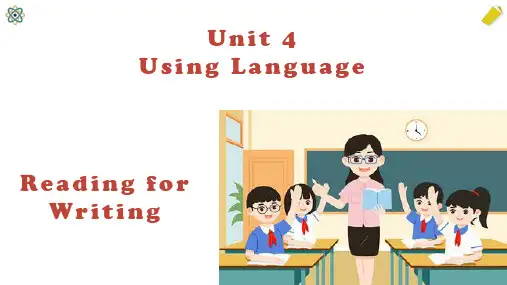高中英语必修五:UNIT4Using language
- 格式:ppt
- 大小:2.28 MB
- 文档页数:15

选择性必修四Unit2 Using Language 单词拓展1.sum up 总结;概括to sum up 总之(做状语)2.with的复合结构with+宾语+adj./adv/介词短语(表示状态)with+宾语+现在分词(表示主动或进行)with+宾语+过去分词(表示被动或完成)with+宾语+动词不定式(表示未做)3.distribution (n).分布;分配;分发geographical distribution 地域分布fair distribution 公平分配food distribution食品分配the distribution of sth.分配某物make the distribution (=distribute) 分发distribute (vt).使分布,分散;分配;分发distribute sth. to/among……把某物分配/分发给……搭配distribute sth. into……将某物分成distributor (n) 经销商;分销商distributive (adj) 经销的;分销的4.phase (n) 阶段;时期the initial/final phase of the project工程的初始/最后阶段a critical/decisive phase 关键性/决定性阶段phase (vt).分阶段进行;逐步做phase in 逐步采用;逐步引入phase out 逐步淘汰;逐步废除5.部分否定的常见用法:①all 的否定式: not all../all….not并非都……,不是所有的都……Eg:Not all bamboo grows tall.并非所有的竹子都会长得很高。
②both的否定式: not...both/both...not并非两个……都……Eg:I don't want both the books.我不是两本书都要。
③every修饰并构成的复合不定代词的否定式:不是每……都……Eg:This flower is not seen everywhere.这花并不是随处可见的。


Unit4 Using Language长难句型精析have+宾语+宾补“have+宾语+宾补”是“have+复合宾语”结构。
have sb. do sth.=make/let sb. do sth.=get sb. to do sth.让某人做某事have sb. doing sth.让某人一直做某事;让某人一直处于某种状态have sth. done使某事被做教材原文Our office would like to have you speak to the park visitors on July 28 at 11:00 am.我们办公室想让你在7月28日上午11点给来公园的参观者演讲。
本句是一个简单句,have you speak是“have+宾语+宾补”结构,此处have是使役动词,意为“让,使”。
经典例句①The soldiers had him stand with his back to his father.这些士兵让他背对着他父亲站着。
②He had us laughing during the lunchtime.他使我们在午饭期间一直笑个不停。
③Before we left we had a photograph taken together.临走前,我们一起拍了一张照片。
即时训练语法填空1.I had my daughter ______________ (practice)talking in English every week.2.I won't have him ______________(shout) in the classroom.3.The doctor said she had better have the medicine ______________(take)half an hour after a meal.答案:1.practice句意:我让女儿每周练习用英语交流。
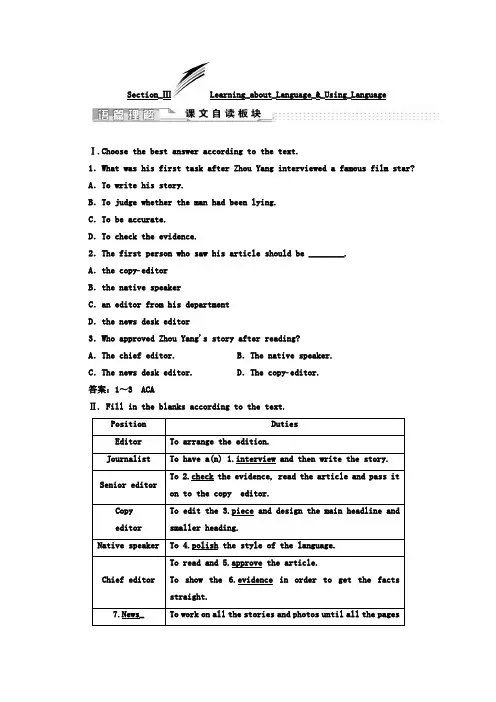
Section_ⅢLearning_about_Language_&_Using_LanguageⅠ.Choose the best answer according to the text.1.What was his first task after Zhou Yang interviewed a famous film star? A.To write his story.B.To judge whether the man had been lying.C.To be accurate.D.To check the evidence.2.The first person who saw his article should be ________.A.the copyeditorB.the native speakerC.an editor from his departmentD.the news desk editor3.Who approved Zhou Yang's story after reading?A.The chief editor. B.The native speaker.C.The news desk editor. D.The copyeditor.答案:1~3 ACAⅡ. Fill in the blanks according to the text.Position DutiesEditor To arrange the edition.Journalist To have a(n) 1.interview and then write the story.Senior editor To 2.check the evidence, read the article and pass it on to the copy editor.Copy editor To edit the 3.piece and design the main headline and smaller heading.Native speaker To 4.polish the style of the language.Chief editor To read and 5.approve the article.To show the 6.evidence in order to get the facts straight.7.News_ To work on all the stories and photos until all the pagesdesk_editor are 8.set.词义配对1.edition A.correct and true in every detail2.department B.to deal with3.accurate C.having a higher position, level, or rank4.senior D.the form a newspaper is produced in5.polish E.an arrangement for a meeting6.approve F.one of the groups of people working together7.process G.to make something shiny by rubbing it8.appointment H. to think that sb./sth. is good, acceptable or suitable 答案:1~5 DFACG 6~8 HBE1.senior[教材原句] The first person who saw his article was a senior editor from his department.第一个看到这篇文章的人是他们部门的一位编审。
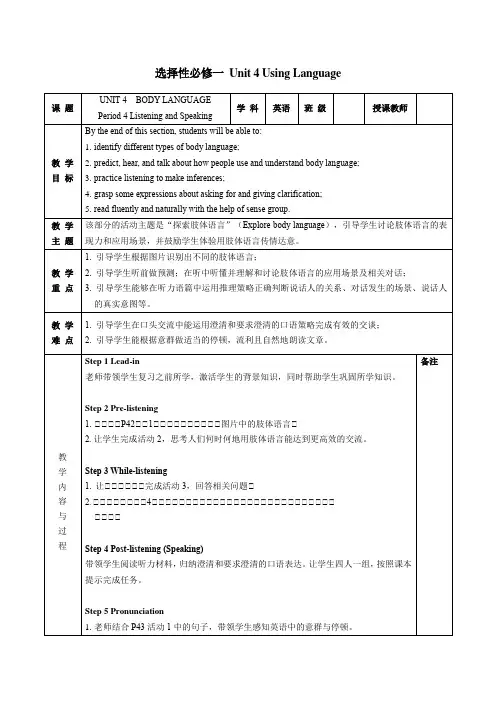

Unit 4 Body LanguageUsing Language教学设计〔2〕Describe classroom bodylanguage科目:英语课题:Using language 课时:1课时教学目标与核心素养:知识目标:掌握肢体语言的表达方式。
能力目标:能够运用肢体语言表达法完成写作任务。
情感目标:激发学生的学习兴趣。
教学重难点教学重点:核心词汇tendency, occupy, stare, perceive, distinguish, anxiety, embarrassed, ashamed, merely, bother, adjust, react, in other words, 使役动词have 的常见用法。
教学难点:引导学生仔细阅读并模仿使用肢体语言的表达法。
课前准备:多媒体,黑板,粉笔教学过程:一、Pre-class1. Greeting2. Leading-in学生活动:根据语篇标题预测语篇内容。
教师活动:As a student, what different feelings have you ever experienced in class? What kind of body language are you aware of?How does a teacher know what’s going on in the mind’s of his/her students?different feels: interested, bored, amused, distracted, troubled, anxious二、While- class学生活动:1、阅读语篇,验证预测内容,找出每段的作用或大意,完成下表,以梳理语篇结构,了解全文框架。
2、学生再次阅读语篇,答复活动1中的四个问题。
教师可根据学生答复的情况进一步追问他们是如何找到答案的,并鼓励学生结合这些问题发表自己的观点或感受。
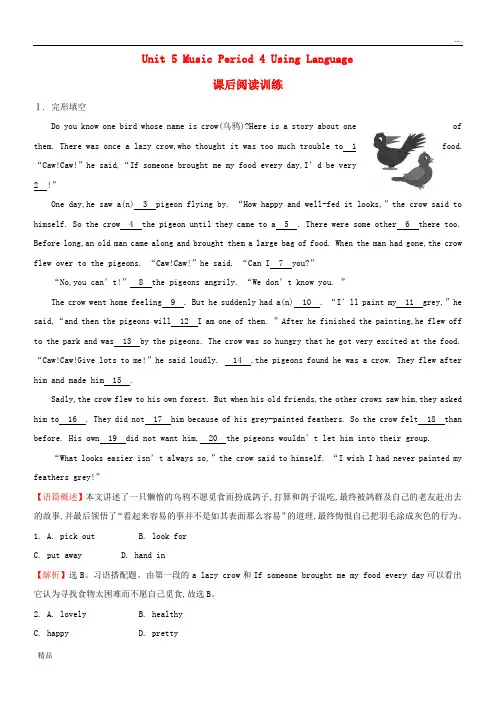
Unit 5 Music Period 4 Using Language课后阅读训练Ⅰ. 完形填空Do you know one bird whose name is crow(乌鸦)?Here is a story about one ofthem. There was once a lazy crow,who thought it was too much trouble to 1 food. “Caw!Caw!”he said,“If someone brought me my food every day,I’d be very2 !”One day,he saw a(n) 3 pigeon flying by. “How happy and well-fed it looks,”the crow said to himself. So the crow 4 the pigeon until they came to a 5 . There were some other 6 there too. Before long,an old man came along and brought them a large bag of food. When the man had gone,the crow flew over to the pigeons. “Caw!Caw!”he said. “Can I7 you?”“No,you can’t!”8 the pigeons angrily. “We don’t know you. ”The crow went home feeling 9 . But he suddenly had a(n) 10 . “I’ll paint my11 grey,”he said,“and then the pigeons will12 I am one of them. ”After he finished the painting,he flew off to the park and was 13 by the pigeons. The crow was so hungry that he got very excited at the food. “Caw!Caw!Give lots to me!”he said loudly. 14 ,the pigeons found he was a crow. They flew after him and made him 15 .Sadly,the crow flew to his own forest. But when his old friends,the other crows saw him,they asked him to 16 . They did not 17 him because of his grey-painted feathers. So the crow felt 18 than before. His own 19 did not want him, 20 the pigeons wouldn’t let him into their group.“What looks easier isn’t always so,”the crow said to himself. “I wish I had never painted my feathers grey!”【语篇概述】本文讲述了一只懒惰的乌鸦不愿觅食而扮成鸽子,打算和鸽子混吃,最终被鸽群及自己的老友赶出去的故事,并最后领悟了“看起来容易的事并不是如其表面那么容易”的道理,最终悔恨自己把羽毛涂成灰色的行为。

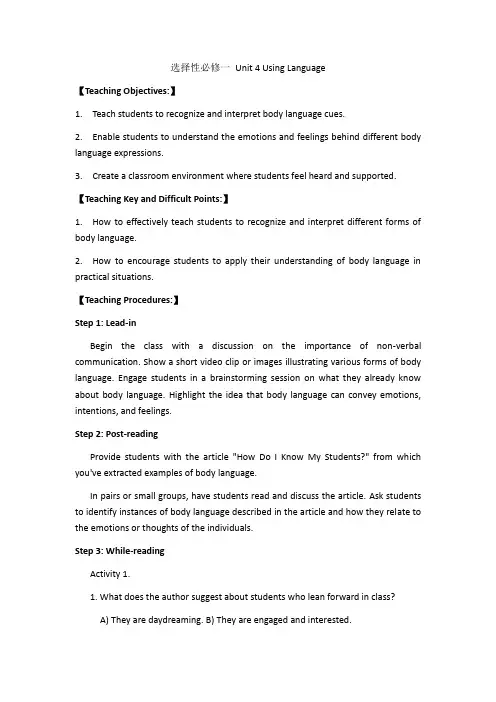
选择性必修一Unit 4 Using Language【Teaching Objectives:】1.Teach students to recognize and interpret body language cues.2.Enable students to understand the emotions and feelings behind different body language expressions.3.Create a classroom environment where students feel heard and supported.【Teaching Key and Difficult Points:】1.How to effectively teach students to recognize and interpret different forms of body language.2.How to encourage students to apply their understanding of body language in practical situations.【Teaching Procedures:】Step 1: Lead-inBegin the class with a discussion on the importance of non-verbal communication. Show a short video clip or images illustrating various forms of body language. Engage students in a brainstorming session on what they already know about body language. Highlight the idea that body language can convey emotions, intentions, and feelings.Step 2: Post-readingProvide students with the article "How Do I Know My Students?" from which you've extracted examples of body language.In pairs or small groups, have students read and discuss the article. Ask students to identify instances of body language described in the article and how they relate to the emotions or thoughts of the individuals.Step 3: While-readingActivity 1.1. What does the author suggest about students who lean forward in class?A) They are daydreaming. B) They are engaged and interested.C) They are angry or afraid. D) They are distracted.2. According to the article, why might a student hide their face in their hands?A) They are embarrassed or ashamed. B) They are excited about the lesson.C) They want to avoid eye contact. D) They are happy.3. Why does the author emphasize the importance of reacting to body language in the classroom?A) To make students uncomfortable. B) To assess students' academic abilities.C) To create a supportive learning environment.D) To encourage students to speak more in class.Activity 2. Present a list of common body language cues (e.g., eye contact, facial expressions, posture, gestures). Discuss each cue's meaning and how it can vary in different contexts.Activity 2. Show images or short video clips of people exhibiting various forms of body language. Have students analyze and interpret the body language cues in these examples.Step 4: Post- readingActivity 1. Provide students with real-life scenarios (e.g., job interviews, social interactions, classroom situations). In pairs or small groups, have students role-play these scenarios while paying attention to their body language. Encourage peer observation and feedback on body language cues during role-play.Activity 2. Lead a class discussion on the importance of empathy in understanding others. Discuss how recognizing body language can lead to more empathetic communication. Have students share their insights and experiences on how body language affects their daily interactions.【Homework Assignment】Assign students to observe and record instances of body language in their daily lives.Have them reflect on how recognizing body language influenced their interactions.Encourage students to write a short reflection essay or share their experiences in the next class.。
